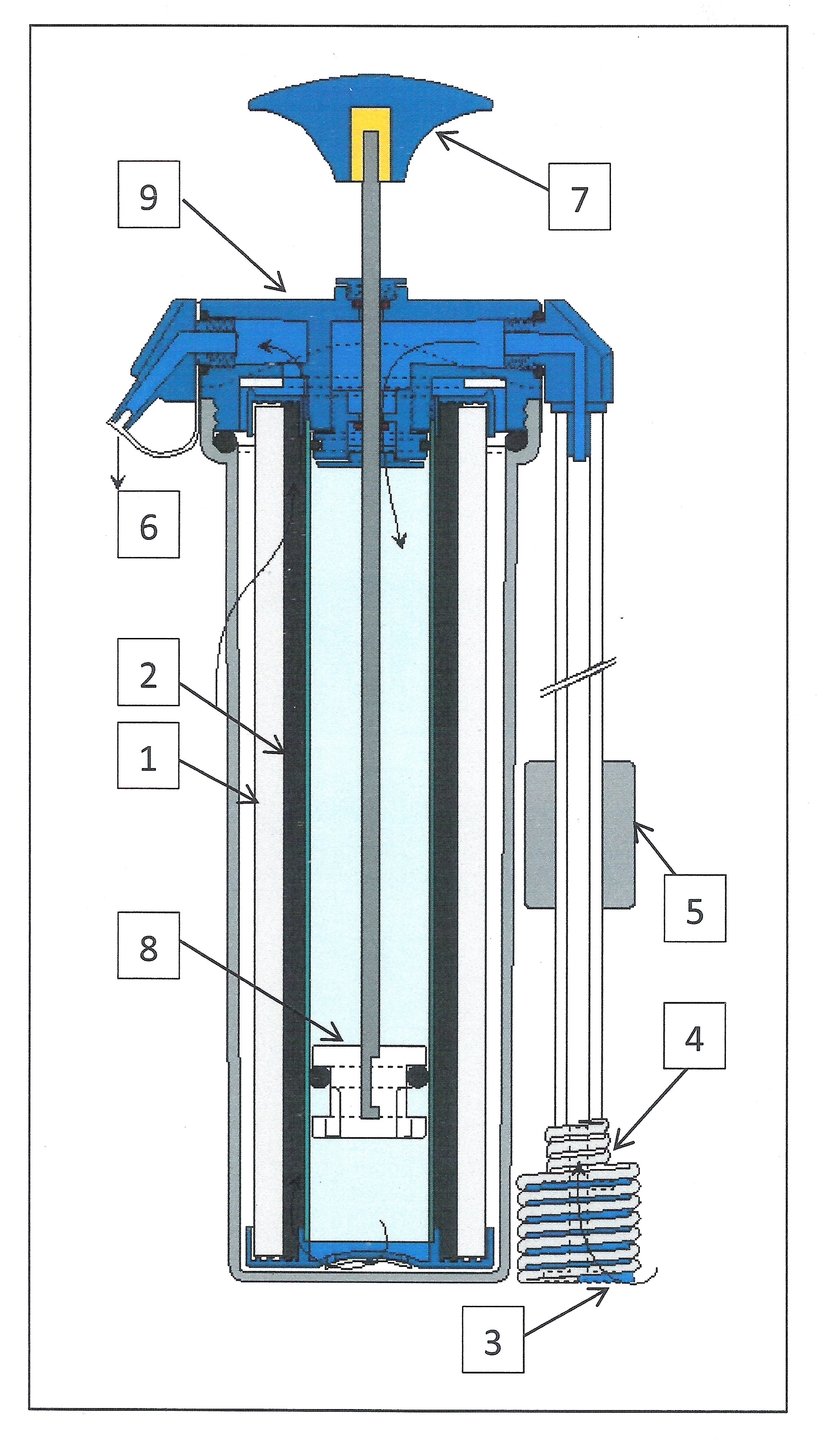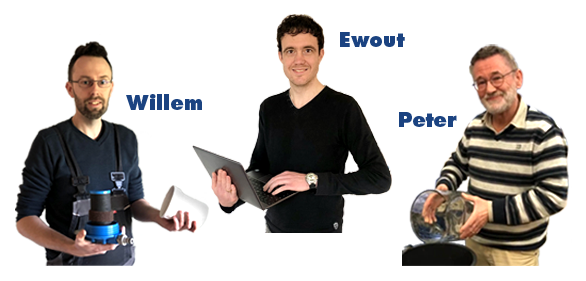Please note: this product is currently unavailable
Due to the complexity of the product and the labor involved, it is currently uncertain whether production will be resumed.
Our focus is now on the production of our gravity, siphon, and inline water filters.
Spare parts and filter elements remain available for the time being.
Water filter properties
The filter element consists of a specially formulated ceramic material (1) in combination with Activated Carbon (2). Both materials are of organic origin and have been treated with Nano silver. The ceramic material has a very small pore through which visible dirt and micro-organisms are captured. (bacterial reduction > 99.99%). In the activated carbon, taste, odor and colorants, as well as chlorine and other chemicals are absorbed, while the presence of Nano silver ensures that microorganisms are rendered harmless.
Floating dirt, sand, etc. are held back by a suction filter (3) attached to the suction hose. This suction filter also has a submersible weight (4), which means that it remains below the water surface and thus no floating dirt and air can be sucked in. The movable float (5) on the suction hose can be slid to the correct height, so that no dirt can be sucked from the bottom.
The filter works without the addition of chemicals and is made up of corrosion-free parts.
The filter surface can be easily cleaned using the supplied cleaning pad.
Usage
It is recommended that you read this manual carefully before using the filter!
Preferably use the filter on a clean surface, so that no dust or dirt can get into the filtered water.
When using surface water for the preparation of drinking water, it is highly recommended to first pour the water through a few layers of (clothing) fabric to remove clay particles and other dirt. This prevents clogging of the filter surface.
Make sure that the suction filter (3) remains well submerged and, if necessary, slide the float (5) to the correct height so that no bottom dirt can be sucked in. Remove the cap (6) from the water spout and move the pump handle (7) up and down with gentle strokes. As a result, water is sucked up and forced through the filter.
Move the pump handle (7) with smooth and controlled strokes. Pumping faster or with a lot of force does not contribute to a higher water yield, but will rather lead to more wear.
With a new/clean filter element, the Travel Mate yields approximately one liter per minute.
With a new filter, the first liters of water (ceramic/coal) may contain grit. Therefore, rinse the filter well until the water is completely clear. If the filter has not been used for some time, it is also recommended to flush the filter.
Close the water outlet after use by means of the integrated cap (6) to prevent the clean water side of the filter from getting contaminated!
Suitable Water Sources for Use with Our AQUA Logic Emergency Water Filters
We recommend to use this AQUA Logic Travel Mate together with the AQUA Logic Travel Mini.
- Rainwater: Easy to collect and directly filter.
- Surface Water: For example, from ditches, lakes, rivers, and streams.
Tip: For optimal results, we recommend pre-filtering surface water with a cloth, such as a tea towel, to remove large contaminants.
- Spring Water: Water from natural springs, if accessible.
- Snow and Ice: Melted snow or ice can be filtered.
Note: Do not use snow or ice that is contaminated with salt or has lost its clear white color.
- Groundwater: Water from shallow wells or boreholes.
Note: If the groundwater contains iron, it can be easily de-ironed by adding oxygen to the water. This can be done by pouring the water back and forth between two buckets. Allow the water to settle so that the iron particles accumulate at the bottom. The clear water on top can then be filtered with the AQUA Logic emergency water filter.
- Rain Puddles: Water collected in depressions after rainfall. Pre-filter large contaminants before filtering.
- Condensed Water: Water collected through condensation, such as with plastic sheets or collection systems.
Note: This filter is not suitable for purifying saltwater or heavily chemically contaminated water.
Groundwater and De-Ironing
Groundwater may contain iron, which can cause a metallic taste and discoloration. You can easily remove iron from the water before filtering it with the AQUA Logic emergency water filter. Follow these steps:
- Add Oxygen: Pour the groundwater back and forth between two buckets several times. This allows the water to absorb oxygen, oxidizing the iron.
- Let it Settle: Allow the water to sit for several hours so the oxidized iron particles settle at the bottom.
- Separate the Water: Carefully scoop or pour the clear water from the top into another bucket, leaving the iron particles at the bottom.
- Filter: The clear water is now ready to be filtered with the AQUA Logic emergency water filter.
This simple method works well for water with low to moderate iron content. For water with high iron levels, additional techniques or tools may be necessary.
Lifespan and Reusability
The Travel-Mate CCS and Mobile - CCS have been tested for bacteria reduction and have proven to be able to filter at least 6000 litres of water without reduced effectiveness. This makes them a reliable choice, even with intensive use.
To extend the life of the filter element, you can clean the ceramic surface when it starts to get clogged. A cleaning pad is included for this purpose, with which you can easily sand the ceramic. If necessary, you can also carefully scrape the surface with a knife, for example.
If the ceramic becomes too thin, you can easily check this with the supplied fitting template. If the filter element reaches the limit value, it is time to replace it.
With these maintenance options, the Travel-Mate offers a practical and sustainable solution for safe drinking water, even under challenging conditions.
After use, the filter can be easily opened and the filter element can be unscrewed for cleaning and to allow it to dry properly. Storing the filter element dry and clean keeps it hygienic and allows it to be reused at any time.
Maintenance
Depending on the degree of contamination of the water to be filtered, the suction filter (3) and/or the surface of the filter element (1) may become clogged. This will be noticeable in the decrease in the amount of outflowing water. In that case, first check whether the suction filter (3) is clean. This can be cleaned if necessary by sliding the immersion weight (metal spring) (4) backwards and rinsing out the foam filter. Replace this foam filter if it is damaged (a spare one is included).
If this does not improve the situation, the lid (9) of the filter housing can be opened and the surface of the filter element can be cleaned. This is done by sanding off dirt with the supplied Cleaning-Pad, after which the dirt can be rinsed off.
Periodically check whether the filter element (1) is still thick enough. This can be checked with the supplied 'caliber' (blue jig). When it fits easily around the filter element, it must be replaced.
Also check that the pump parts (plunger and rubber ring) (8) are clean. The pump is
accessible by unscrewing the filter element (1) (counterclockwise). Lubricate the plunger ring and the pump shaft (8) with the supplied silicone grease. Never use other lubricants for this!
When replacing the filter element, make sure the sealing ring is clean and properly installed. Then tighten the filter element well (by hand) to prevent leakage of dirty water!
When closing the housing, make sure that the rubber sealing ring is clean and well placed in the edge of the housing. In case of damage or loss, use the supplied spare ring.
Even after maintenance, rinse the filter well before using water for consumption!
When the filters are not used for a longer period of time, it is recommended to open the filter housing and let the filters dry. When using the filter again, it is recommended to flush the filter for a few minutes.
Disclaimer
This water filter is designed to reduce a wide range of contaminants to levels generally considered safe for daily use. However, it may not be effective against water heavily contaminated with industrial chemicals or hazardous substances. Although water quality is significantly improved, the filter is not intended for specialized or medical use. Individuals with weakened immune systems or specific health concerns are advised to take extra precautions and consult a professional if necessary.










